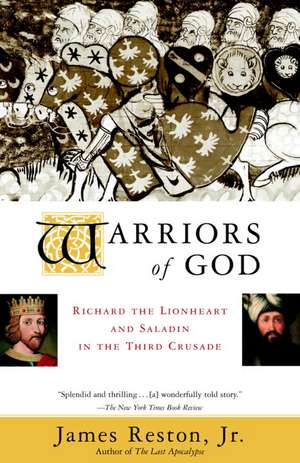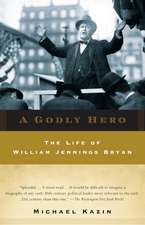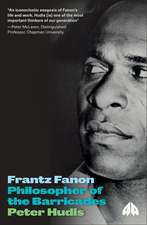Warriors of God: Richard the Lionheart and Saladin in the Third Crusade
Autor Jr. Reston, Jamesen Limba Engleză Paperback – 30 apr 2002
As he recounts this rousing story, Reston brings to life the two legendary figures who led their armies against each other. He offers compelling portraits of Saladin, the wise and highly cultured leader who created a united empire, and Richard the Lionheart, the romantic personification of chivalry who emerges here in his full complexity and contradictions. From its riveting scenes of blood-soaked battles to its pageant of fascinating, larger-than-life characters, Warriors of God is essential history, history that helps us understand today's world.
Preț: 119.74 lei
Nou
Puncte Express: 180
Preț estimativ în valută:
22.91€ • 23.92$ • 18.96£
22.91€ • 23.92$ • 18.96£
Carte disponibilă
Livrare economică 15-29 martie
Preluare comenzi: 021 569.72.76
Specificații
ISBN-13: 9780385495622
ISBN-10: 0385495625
Pagini: 448
Ilustrații: 16 PAGES OF ILLUS.; 4 MAPS
Dimensiuni: 132 x 204 x 24 mm
Greutate: 0.41 kg
Ediția:Anchor Books.
Editura: Anchor Books
ISBN-10: 0385495625
Pagini: 448
Ilustrații: 16 PAGES OF ILLUS.; 4 MAPS
Dimensiuni: 132 x 204 x 24 mm
Greutate: 0.41 kg
Ediția:Anchor Books.
Editura: Anchor Books
Notă biografică
James Reston, Jr. is a journalist and the author of more than a dozen books, including The Last Apocalypse, Dogs of God,and Galileo: A Life. He lives in Chevy Chase, Maryland.
Extras
chapter one
A Sultan Is Born
Early in the twelfth century, in the city of Tovin in northern Armenia close to Georgia, there lived an eminent family of Kurds, the master of whose house was surnamed Najm ad-Din, which meant "excellent prince and star of religion." Najm ad-Din had a boon comrade named Bihruz, a man of intelligence and charm, qualities matched only by his bent for trouble. Bihruz had the misfortune to be discovered in a compromising position with the wife of the local emir, who promptly had Bihruz seized and castrated and banished from his fief.
After this humiliation Najm ad-Din decided to accompany his disgraced friend to Baghdad, the seat of the Abbasid caliphate, where the Caliph, Al Muqtafi li-amri'llah ("he who follows the orders of God"), reigned supreme over the Muslim world of the eastern Mediterranean. In Baghdad the Sultan of Iraq noticed their talents. Since eunuchs were then favored as teachers and administrators, Bihruz became the tutor of the Sultan's sons and a companion to the Sultan himself in the games of chess and draughts. He rose quickly in power and influence and soon became responsible for building some of the great buildings of the land. In his rise to power Bihruz brought his friend, Najm ad-Din, along with him. Among the rewards the Sultan bestowed on Bihruz for his service was the castle at Takreet, on the Tigris River, and Bihruz in turn bestowed the command of it on his friend, Najm ad-Din.
At the castle in Takreet, Najm ad-Din was joined by his younger and more ambitious brother, named Shirkuh, and together these Kurds from the north seemed marked for greatness. For the Arab world had arrived at a critical juncture in its history. Forty years earlier, in the year 1098, Europeans had descended on Palestine, conquering Jerusalem in what the Franks called a crusade and establishing a powerful state called the Kingdom of Jerusalem, which stretched from Antioch in the north to Elath on the Red Sea. Along the coastline and in the mountains the foreigners built huge fortresses to protect their kingdom, and thus the Muslim world was fractured and invaded, beaten, and occupied.
In the year 532 (a.d. 1137 in the Christian calendar) a son named Yusuf was born to Najm ad-Din. In Arab lands this was an ambiguous name, which was associated with all the vicissitudes of the life of Joseph the Prophet, the low life as well as the high, the greed and falseness as well as the piety and truth. The circumstances of Yusuf's birth seemed ominous as well. For on the very night that Yusuf was born, the child's uncle, Shirkuh, had a dispute with the Isfahsalar, commander at the castle gate, after the officer had insulted a woman and she had come to Shirkuh in tears. In a rage Shirkuh snatched the halberd of the commander and killed him with his own weapon. When their powerful patron, the eunuch Bihruz, heard of this in Baghdad, he was appalled and banished the brothers from Takreet in disgrace. That so terrible an event accompanied the birth of Yusuf was considered a bad sign, but later it would be said, "Good may come of adversity when you least expect it. And such was the case with Yusuf." From Takreet the brothers went to Mosul in northern Mesopotamia.
In Mosul, in the face of the European occupation of Palestine, a strong Arab leader named Zengy had taken power and was making strides in uniting the far-flung domains of Islam, where Mesopotamia was traditionally divided from Syria, where Antioch fought with Aleppo, Tripoli with Homs, Jerusalem with Damascus, where the Sunni branch of Islam fought with the Shi'ite branch. In his quest to overcome the divisions of the Muslim world, Zengy called these Kurdish brothers to his service. Najm ad-Din became the commander of Zengy's fortress in Baalbek in the Bekaa Valley, while Shirkuh became a powerful commander in the vizier's armies.
In November 1144, Zengy's forces captured Edessa in northern Mesopotamia, and thus the first of the fledgling Crusader provinces fell. The fall of Edessa was a shock to Europe. Largely through the eloquence of the Cistercian monk Bernard of Clairvaux, a campaign for a new Crusade began, and among the first to heed this call was the King of France, Louis VII, and his Queen, Eleanor of Aquitaine. In 1146, before the new Crusaders arrived in the Holy Land, Zengy died, and he was replaced by an even more powerful figure, Nur ad-Din. Two years later the Crusader forces were crushed outside the walls of Damascus, turning the Second Crusade into a total disaster and emboldening the forces of Islam further in their quest for the reconquest of Palestine.
The boy, Yusuf, grew up in Baalbek and Damascus. Though he was slight of build, his intelligence, his mannerliness, his generosity, his piety, and his modesty were noticed in the palaces of Damascus. Like a few others of his age, he was drawn to wine and women in his adolescence, but the seriousness of the historical situation eventually impressed him, and he renounced these temptations. Later it would be said that from the education of his sovereign, Nur ad-Din, Yusuf--later called Salah ad-Din or Saladin--learned to walk in the path of righteousness, to act virtuously, and to be zealous in waging war against infidels. In the court of Damascus the principle of striving in Allah's cause was emphasized, and the youth took to heart this invocation in the Koran: "Those who strive in Our Cause, we will surely guide in Our way, for verily Allah is with those who do right."
In 1163 Nur ad-Din saw clearly the next step in the unification of the Arab world against the European occupation. In Egypt the Fatimite caliphate (which practiced the Shi'ite rather than the Sunni way of Islam) was in disarray, and this presented the lord of Syria with a target of opportunity. Nur ad-Din ordered Shirkuh, Saladin's charismatic uncle, to undertake a succession of invasions to the south and ordered the young Saladin, now twenty-six years old, to accompany his uncle. Reluctantly, Saladin complied.
As Shirkuh and Saladin headed south, Nur ad-Din himself laid siege to the greatest of all the Crusader castles, Krak des Chevaliers, in central Syria, but the fortress was impregnable and the Muslim forces were turned back. The time was not yet ripe for a frontal assault on the Crusader kingdom.
In 1164, with Saladin in command of the vanguard of the army, Shirkuh conquered Cairo. But within weeks he was forced to withdraw when Crusader forces came to the aid of the Egyptian caliphate. Three years later a second invasion failed, again due to the support of the Crusaders, for above all else the Crusader kingdom could not abide a united Egypt and Syria. So desperate was this crisis considered in the Crusader kingdom that any baron refusing to heed the summons forfeited 10 percent of his income. Two further invasions faltered, until on January 8, 1169, in the fifth attempt, Shirkuh entered Cairo in triumph. Gloriously, he proclaimed himself to be the new King of Egypt--and then, abruptly, died two months later. Poison was suspected.
Pondering this reverse in Damascus, Nur ad-Din settled on Saladin as his uncle's successor. The young soldier was chosen not because of his strengths but because of the perceived weaknesses of his youth and inexperience. In truth, Nur ad-Din did not want a powerful competitor in Cairo, and he was certain that he could control his malleable and polite ward. In this he would be disappointed.
At first Saladin was the compliant subordinate. Mercilessly, he followed Nur ad-Din's orders to expunge the Shi'ite way of Islam in Egypt and replace it with the Sunni way. He requested of his lord that his father, Najm ad-Din, be allowed to come to Cairo. "My happiness will thus be complete," he wrote to his lord in Damascus, "and my adventure will be similar to that of Yusuf [Joseph] the faithful." Nur ad-Din granted the request. When Najm ad-Din arrived in the spring of 1170, his son greeted him with honors, even offering to resign and turn the command of Egypt over to his father. But his father replied, "O my son, God would not have chosen you to fill this post if you were not deserving of it. It is not right to change the object of Fortune's favors." Two years later, while riding near the Gate of Victory, the Bab an-Nasr, Najm ad-Din was thrown from his horse and died.
Between 1169 and 1174, while successive Crusader attacks sought unsuccessfully to undermine the grip of Damascus on Egypt, Nur ad-Din and Saladin developed an increasingly tense relationship after Saladin balked at certain directives from Damascus. Finally, in early 1174, Nur ad-Din had had enough of this impudence and mustered an army to invade Saladin's Egypt. But on May 15 of that year, as these preparations were under way, Nur ad-Din died. Absurdly, his power was handed to his eleven-year-old son.
A year later Saladin led an army out of Egypt and took control of Syria. He was proclaimed the Sultan of Syria and Egypt, and his vast empire now held the Crusader kingdom in its grip like a lobster claw.
Only because of the divisions among petty potentates, because of the feud between the Islamic sects of the Sunnis and the Shi'ites and between competing caliphates in Egypt and Syria and Turkey had the First Crusade succeeded. But gradually, with a slow inevitability that was almost providential, the Arab world consolidated its power in the face of the European occupation. The Arab recapture of Edessa had been the critical first step, and the failure of the Second Crusade gave the Islamic world confidence that it could drive the Christians into the sea. A succession of three strong Arab leaders advanced the union of the Arabs: the able Zengy who had recaptured Edessa and ruled until his death in 1147, the powerful Nur ad-Din who united all of Muslim Syria and Mesopotamia under Sunnism and subdued Egypt in 1169, and now Saladin.
When in 1175, at the age of thirty-eight, Saladin took power in both Damascus and Cairo, the centuries-old divisions evaporated. The Fatamid caliphate of Egypt was finished, and with its demise the Sunnism of the north supplanted Shi'ism along the Nile. In the spring of 1175, Saladin was declared King of Syria and was recognized as the Emperor of Syria and Egypt by the titular leader in the Middle East, the Caliph in Baghdad.
"When God gave me the land of Egypt, I was sure that he meant Palestine for me as well," Saladin proclaimed.
The dream of a united front against the Christians was a reality at last. That Arab dream was the Christian nightmare. For ninety years, through skillful alliances and offensive, destabilizing raids and strategic castles, the Latin Kingdom had kept its enemies off balance. The survival of the Latin Kingdom would now depend on its internal discipline and its military skill.
Before his final offensive began, the Sultan had one remaining task to accomplish within his own empire. He needed to subdue the last of the independent fiefs. In 1183, in the Muslim month of Safar (June) and after the death of a child-emir, he captured Aleppo. Beyond the military importance of the city, this triumph was fraught with symbolic importance. Aleppo was known as the Gray Castle, and among the public there was a popular saying that presaged even greater triumphs ahead:
Thy taking of the Gray Castle in the month of Safar announces the conquest of Jerusalem for the month of Rajab.
In 1186 the Sultan took Mosul in Upper Mesopotamia. He was well poised to strike. The month of Rajab was in the offing.
chapter two
The Kingdom of Heaven
The Latin Kingdom of Jerusalem had come into existence eighty-nine years earlier with the First Crusade. In 1098 Godfrey of Bouillon had stormed the walls of the Holy City and massacred the Muslim defenders by the thousands. The stone streets of Jerusalem ran with blood, through which the victorious Crusaders waded before falling to their knees in a mass of thanksgiving at the Holy Sepulcher.
Thirty years later the small kingdom was at the peak of its power. Christian knights pushed its boundaries outward as if the Muslim world were a feather pillow. The kingdom had thrived on the division of the enemy. The thousand tribes of Arabia had their minor emirs and viziers, who aligned themselves with the caliphates of either Cairo or Baghdad, fought over petty disputes, and prayed as part of either the Sunni or the Shi'ite sects of Islam.
By 1131 the Crusader kingdom comprised the greater part of Palestine and the coast of Syria. The European invaders, who over time became known generically as Franks, concentrated in the important coastal cities of Latakia, Tortosa, Tripoli, Beirut, Tyre, Acre, Haifa, Caesarea, Jaffa, and Ascalon, as well as the inland cities of Edessa, Antioch, Tiberias, and, most important, Jerusalem itself. The rural areas were left largely to the native population, who outnumbered their overlords five to one. In their bucolic pastures the natives cultivated their crops in peace and were content to give half the harvest to their absentee landlords from abroad. These indigenous peoples were allowed to govern themselves.
In its entirety the population of the precious kingdom was about 250,000. Its leading cities of Jerusalem and Acre had about 25,000 residents (although in the aftermath of the massacre of Jerusalem, only a few streets were occupied and the new Crusader lords were forced to recruit inhabitants from other regions as the crusading army went home). The north of the kingdom was divided into nominally independent provinces: the principality of Antioch, and the counties of Edessa and Tripoli, whose lords were vassals of the King of Jerusalem to their south. With a few exceptions the grand personages of the Crusader kingdom had been the lesser personages of Europe, younger sons of minor households who had no real future on the Continent and had come to the Orient in search of wealth and position and adventure.
Against the seemingly inexhaustible manpower of the Muslim world the Christians had built their formidable network of great castles. This defensive system of strongholds stretched along the coast, and the castles were within sight of one another, so that signal fires could be seen from one to another. By a system of smoke and fire, the great fortress of el Kerak in the Transjordan, for example, could communicate with Jerusalem at night, over a distance of seventy miles. On mountaintops hovering over strategic valleys, these fortresses dotted the landscape at regular intervals.
The military monks, the Templars and the Hospitalers, were the backbone of Christian power. These zealots were former nobles who had given up their jewels and castles and ladies in Europe to take a solemn and chaste vow to defend the Holy Land. For a monk in a Christian order to bear arms spoke to the profound transformation that the concept of Holy War had wrought in the church. St. Martin had expressed the original orthodoxy in the fourth century: "I am a soldier of Christ. I must not fight." To shed blood in combat was sinful, and on no account could a holy man have anything to do with temporal conflicts. The church strictly forbade not only fighting but the bearing of arms.
A Sultan Is Born
Early in the twelfth century, in the city of Tovin in northern Armenia close to Georgia, there lived an eminent family of Kurds, the master of whose house was surnamed Najm ad-Din, which meant "excellent prince and star of religion." Najm ad-Din had a boon comrade named Bihruz, a man of intelligence and charm, qualities matched only by his bent for trouble. Bihruz had the misfortune to be discovered in a compromising position with the wife of the local emir, who promptly had Bihruz seized and castrated and banished from his fief.
After this humiliation Najm ad-Din decided to accompany his disgraced friend to Baghdad, the seat of the Abbasid caliphate, where the Caliph, Al Muqtafi li-amri'llah ("he who follows the orders of God"), reigned supreme over the Muslim world of the eastern Mediterranean. In Baghdad the Sultan of Iraq noticed their talents. Since eunuchs were then favored as teachers and administrators, Bihruz became the tutor of the Sultan's sons and a companion to the Sultan himself in the games of chess and draughts. He rose quickly in power and influence and soon became responsible for building some of the great buildings of the land. In his rise to power Bihruz brought his friend, Najm ad-Din, along with him. Among the rewards the Sultan bestowed on Bihruz for his service was the castle at Takreet, on the Tigris River, and Bihruz in turn bestowed the command of it on his friend, Najm ad-Din.
At the castle in Takreet, Najm ad-Din was joined by his younger and more ambitious brother, named Shirkuh, and together these Kurds from the north seemed marked for greatness. For the Arab world had arrived at a critical juncture in its history. Forty years earlier, in the year 1098, Europeans had descended on Palestine, conquering Jerusalem in what the Franks called a crusade and establishing a powerful state called the Kingdom of Jerusalem, which stretched from Antioch in the north to Elath on the Red Sea. Along the coastline and in the mountains the foreigners built huge fortresses to protect their kingdom, and thus the Muslim world was fractured and invaded, beaten, and occupied.
In the year 532 (a.d. 1137 in the Christian calendar) a son named Yusuf was born to Najm ad-Din. In Arab lands this was an ambiguous name, which was associated with all the vicissitudes of the life of Joseph the Prophet, the low life as well as the high, the greed and falseness as well as the piety and truth. The circumstances of Yusuf's birth seemed ominous as well. For on the very night that Yusuf was born, the child's uncle, Shirkuh, had a dispute with the Isfahsalar, commander at the castle gate, after the officer had insulted a woman and she had come to Shirkuh in tears. In a rage Shirkuh snatched the halberd of the commander and killed him with his own weapon. When their powerful patron, the eunuch Bihruz, heard of this in Baghdad, he was appalled and banished the brothers from Takreet in disgrace. That so terrible an event accompanied the birth of Yusuf was considered a bad sign, but later it would be said, "Good may come of adversity when you least expect it. And such was the case with Yusuf." From Takreet the brothers went to Mosul in northern Mesopotamia.
In Mosul, in the face of the European occupation of Palestine, a strong Arab leader named Zengy had taken power and was making strides in uniting the far-flung domains of Islam, where Mesopotamia was traditionally divided from Syria, where Antioch fought with Aleppo, Tripoli with Homs, Jerusalem with Damascus, where the Sunni branch of Islam fought with the Shi'ite branch. In his quest to overcome the divisions of the Muslim world, Zengy called these Kurdish brothers to his service. Najm ad-Din became the commander of Zengy's fortress in Baalbek in the Bekaa Valley, while Shirkuh became a powerful commander in the vizier's armies.
In November 1144, Zengy's forces captured Edessa in northern Mesopotamia, and thus the first of the fledgling Crusader provinces fell. The fall of Edessa was a shock to Europe. Largely through the eloquence of the Cistercian monk Bernard of Clairvaux, a campaign for a new Crusade began, and among the first to heed this call was the King of France, Louis VII, and his Queen, Eleanor of Aquitaine. In 1146, before the new Crusaders arrived in the Holy Land, Zengy died, and he was replaced by an even more powerful figure, Nur ad-Din. Two years later the Crusader forces were crushed outside the walls of Damascus, turning the Second Crusade into a total disaster and emboldening the forces of Islam further in their quest for the reconquest of Palestine.
The boy, Yusuf, grew up in Baalbek and Damascus. Though he was slight of build, his intelligence, his mannerliness, his generosity, his piety, and his modesty were noticed in the palaces of Damascus. Like a few others of his age, he was drawn to wine and women in his adolescence, but the seriousness of the historical situation eventually impressed him, and he renounced these temptations. Later it would be said that from the education of his sovereign, Nur ad-Din, Yusuf--later called Salah ad-Din or Saladin--learned to walk in the path of righteousness, to act virtuously, and to be zealous in waging war against infidels. In the court of Damascus the principle of striving in Allah's cause was emphasized, and the youth took to heart this invocation in the Koran: "Those who strive in Our Cause, we will surely guide in Our way, for verily Allah is with those who do right."
In 1163 Nur ad-Din saw clearly the next step in the unification of the Arab world against the European occupation. In Egypt the Fatimite caliphate (which practiced the Shi'ite rather than the Sunni way of Islam) was in disarray, and this presented the lord of Syria with a target of opportunity. Nur ad-Din ordered Shirkuh, Saladin's charismatic uncle, to undertake a succession of invasions to the south and ordered the young Saladin, now twenty-six years old, to accompany his uncle. Reluctantly, Saladin complied.
As Shirkuh and Saladin headed south, Nur ad-Din himself laid siege to the greatest of all the Crusader castles, Krak des Chevaliers, in central Syria, but the fortress was impregnable and the Muslim forces were turned back. The time was not yet ripe for a frontal assault on the Crusader kingdom.
In 1164, with Saladin in command of the vanguard of the army, Shirkuh conquered Cairo. But within weeks he was forced to withdraw when Crusader forces came to the aid of the Egyptian caliphate. Three years later a second invasion failed, again due to the support of the Crusaders, for above all else the Crusader kingdom could not abide a united Egypt and Syria. So desperate was this crisis considered in the Crusader kingdom that any baron refusing to heed the summons forfeited 10 percent of his income. Two further invasions faltered, until on January 8, 1169, in the fifth attempt, Shirkuh entered Cairo in triumph. Gloriously, he proclaimed himself to be the new King of Egypt--and then, abruptly, died two months later. Poison was suspected.
Pondering this reverse in Damascus, Nur ad-Din settled on Saladin as his uncle's successor. The young soldier was chosen not because of his strengths but because of the perceived weaknesses of his youth and inexperience. In truth, Nur ad-Din did not want a powerful competitor in Cairo, and he was certain that he could control his malleable and polite ward. In this he would be disappointed.
At first Saladin was the compliant subordinate. Mercilessly, he followed Nur ad-Din's orders to expunge the Shi'ite way of Islam in Egypt and replace it with the Sunni way. He requested of his lord that his father, Najm ad-Din, be allowed to come to Cairo. "My happiness will thus be complete," he wrote to his lord in Damascus, "and my adventure will be similar to that of Yusuf [Joseph] the faithful." Nur ad-Din granted the request. When Najm ad-Din arrived in the spring of 1170, his son greeted him with honors, even offering to resign and turn the command of Egypt over to his father. But his father replied, "O my son, God would not have chosen you to fill this post if you were not deserving of it. It is not right to change the object of Fortune's favors." Two years later, while riding near the Gate of Victory, the Bab an-Nasr, Najm ad-Din was thrown from his horse and died.
Between 1169 and 1174, while successive Crusader attacks sought unsuccessfully to undermine the grip of Damascus on Egypt, Nur ad-Din and Saladin developed an increasingly tense relationship after Saladin balked at certain directives from Damascus. Finally, in early 1174, Nur ad-Din had had enough of this impudence and mustered an army to invade Saladin's Egypt. But on May 15 of that year, as these preparations were under way, Nur ad-Din died. Absurdly, his power was handed to his eleven-year-old son.
A year later Saladin led an army out of Egypt and took control of Syria. He was proclaimed the Sultan of Syria and Egypt, and his vast empire now held the Crusader kingdom in its grip like a lobster claw.
Only because of the divisions among petty potentates, because of the feud between the Islamic sects of the Sunnis and the Shi'ites and between competing caliphates in Egypt and Syria and Turkey had the First Crusade succeeded. But gradually, with a slow inevitability that was almost providential, the Arab world consolidated its power in the face of the European occupation. The Arab recapture of Edessa had been the critical first step, and the failure of the Second Crusade gave the Islamic world confidence that it could drive the Christians into the sea. A succession of three strong Arab leaders advanced the union of the Arabs: the able Zengy who had recaptured Edessa and ruled until his death in 1147, the powerful Nur ad-Din who united all of Muslim Syria and Mesopotamia under Sunnism and subdued Egypt in 1169, and now Saladin.
When in 1175, at the age of thirty-eight, Saladin took power in both Damascus and Cairo, the centuries-old divisions evaporated. The Fatamid caliphate of Egypt was finished, and with its demise the Sunnism of the north supplanted Shi'ism along the Nile. In the spring of 1175, Saladin was declared King of Syria and was recognized as the Emperor of Syria and Egypt by the titular leader in the Middle East, the Caliph in Baghdad.
"When God gave me the land of Egypt, I was sure that he meant Palestine for me as well," Saladin proclaimed.
The dream of a united front against the Christians was a reality at last. That Arab dream was the Christian nightmare. For ninety years, through skillful alliances and offensive, destabilizing raids and strategic castles, the Latin Kingdom had kept its enemies off balance. The survival of the Latin Kingdom would now depend on its internal discipline and its military skill.
Before his final offensive began, the Sultan had one remaining task to accomplish within his own empire. He needed to subdue the last of the independent fiefs. In 1183, in the Muslim month of Safar (June) and after the death of a child-emir, he captured Aleppo. Beyond the military importance of the city, this triumph was fraught with symbolic importance. Aleppo was known as the Gray Castle, and among the public there was a popular saying that presaged even greater triumphs ahead:
Thy taking of the Gray Castle in the month of Safar announces the conquest of Jerusalem for the month of Rajab.
In 1186 the Sultan took Mosul in Upper Mesopotamia. He was well poised to strike. The month of Rajab was in the offing.
chapter two
The Kingdom of Heaven
The Latin Kingdom of Jerusalem had come into existence eighty-nine years earlier with the First Crusade. In 1098 Godfrey of Bouillon had stormed the walls of the Holy City and massacred the Muslim defenders by the thousands. The stone streets of Jerusalem ran with blood, through which the victorious Crusaders waded before falling to their knees in a mass of thanksgiving at the Holy Sepulcher.
Thirty years later the small kingdom was at the peak of its power. Christian knights pushed its boundaries outward as if the Muslim world were a feather pillow. The kingdom had thrived on the division of the enemy. The thousand tribes of Arabia had their minor emirs and viziers, who aligned themselves with the caliphates of either Cairo or Baghdad, fought over petty disputes, and prayed as part of either the Sunni or the Shi'ite sects of Islam.
By 1131 the Crusader kingdom comprised the greater part of Palestine and the coast of Syria. The European invaders, who over time became known generically as Franks, concentrated in the important coastal cities of Latakia, Tortosa, Tripoli, Beirut, Tyre, Acre, Haifa, Caesarea, Jaffa, and Ascalon, as well as the inland cities of Edessa, Antioch, Tiberias, and, most important, Jerusalem itself. The rural areas were left largely to the native population, who outnumbered their overlords five to one. In their bucolic pastures the natives cultivated their crops in peace and were content to give half the harvest to their absentee landlords from abroad. These indigenous peoples were allowed to govern themselves.
In its entirety the population of the precious kingdom was about 250,000. Its leading cities of Jerusalem and Acre had about 25,000 residents (although in the aftermath of the massacre of Jerusalem, only a few streets were occupied and the new Crusader lords were forced to recruit inhabitants from other regions as the crusading army went home). The north of the kingdom was divided into nominally independent provinces: the principality of Antioch, and the counties of Edessa and Tripoli, whose lords were vassals of the King of Jerusalem to their south. With a few exceptions the grand personages of the Crusader kingdom had been the lesser personages of Europe, younger sons of minor households who had no real future on the Continent and had come to the Orient in search of wealth and position and adventure.
Against the seemingly inexhaustible manpower of the Muslim world the Christians had built their formidable network of great castles. This defensive system of strongholds stretched along the coast, and the castles were within sight of one another, so that signal fires could be seen from one to another. By a system of smoke and fire, the great fortress of el Kerak in the Transjordan, for example, could communicate with Jerusalem at night, over a distance of seventy miles. On mountaintops hovering over strategic valleys, these fortresses dotted the landscape at regular intervals.
The military monks, the Templars and the Hospitalers, were the backbone of Christian power. These zealots were former nobles who had given up their jewels and castles and ladies in Europe to take a solemn and chaste vow to defend the Holy Land. For a monk in a Christian order to bear arms spoke to the profound transformation that the concept of Holy War had wrought in the church. St. Martin had expressed the original orthodoxy in the fourth century: "I am a soldier of Christ. I must not fight." To shed blood in combat was sinful, and on no account could a holy man have anything to do with temporal conflicts. The church strictly forbade not only fighting but the bearing of arms.
Recenzii
"Splendid and thrilling. . . . [A] wonderfully told story."--The New York Times Book Review
“A refreshingly unbiased popular history of the Third Crusade which deserves a place on the shelf of every history teacher.” —The Washington Post Book World
“Reading this book, one sways between horror and exhilaration. The magnitude of human suffering is mind-boggling, but the warriors’ adventures are the stuff of boyhood fantasy.” —Forbes FYI
"Remarkably intimate and engagingly detailed."--Kirkus Reviews
“A refreshingly unbiased popular history of the Third Crusade which deserves a place on the shelf of every history teacher.” —The Washington Post Book World
“Reading this book, one sways between horror and exhilaration. The magnitude of human suffering is mind-boggling, but the warriors’ adventures are the stuff of boyhood fantasy.” —Forbes FYI
"Remarkably intimate and engagingly detailed."--Kirkus Reviews
Descriere
Bringing to life a rich pageant of legendary characters, a respected historian's account of the Third Crusade is a grand telling of an epic battle that shaped the course of history. of illustrations. 4 maps.













